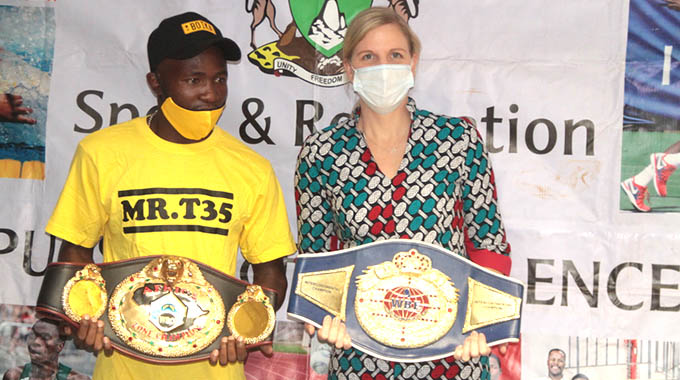2020: Year of agric recovery

Elita Chikwati Agriculture Reporter
With good rains falling, inputs delivered on time, and new methods of preparing land and conserving moisture in place, 2020 is seen as the start of a green revolution that moves the bulk of Zimbabwean farming households out of the poverty trap of subsistence farming and help advance the country’s Vision 2030.
Farming provides a living for a majority of Zimbabweans, making investment in the sector critical if the country is to become a middle-income economy by 2030, with most of its households in the middle-income group.
The major programmes launched and refined by the Second Republic are meant to first ensure agriculture recovered and then grows sufficiently fast and inclusively.
Besides hammering rural poverty, the agriculture reform and growth programmes are designed to ensure that Zimbabwe is self-sufficient in all major food sources and that adequate raw materials are produced to feed the growing industrial base.
The year 2020 was also confronted with some challenges, chief among them the Covid-19 pandemic and the largely successful measures, including a national lockdown, implemented to control the infections rates.
But there were casualties, including one of the masterminds behind the agricultural revolution, the late Lands, Agriculture, Water and Rural Resettlement Minister Perrance Shiri, who had the passion to see the sector retaining its position of stirring economic growth.
President Mnangagwa launched the Agriculture and Food Systems Transformation Strategy, which is aimed at achieving over US$8 billion gross agriculture production value by 2025 and increase the contribution of agriculture to the GDP from 12 to 20 percent, and that is in an expanding economy generally, so farmers have to do better than most.
The strategy includes the Agriculture Recovery Plan, Livestock Growth Plan and Horticulture Recovery Plan.
Global Political Agreement
The year 2020 saw the signing a series of agreements under the Global Compensation Deed signed between Government and representatives of white former commercial farmers closing the chapter on land reform.
This will see 4 000 white commercial farmers who lost their farms during land reform sharing US$3,5 billion compensation for improvements, although there is no compensation for the actual land.
But, for those who developed and invested in their farms, almost the entire worth of those farms was in improvements.
The agreement demonstrated the Second Republic’s commitment to re-engagement and constitutionalism.
The agreement, while putting finality to the land issue, also sealed its irreversibility and sent a message to investors that Zimbabweans could work together and that the country was truly open for business.
Some people at first failed to understand the deal and thought Government was returning land to the former farmers.
They were enlightened that the land reform programme was irreversible and there would be no major disruptions to agriculture, as only a few indigenous farmers were likely to be affected by reallocations.
Only 37 farms covered by Bilateral Investment Promotion and Protection Agreements (BIPPAS) would be offered back to farmers who were dispossessed.
The climate proofed Presidential inputs scheme (Pfumvudza/Intwasa) under the Agriculture Recovery Plan was spearheaded in 2020 to boost crop production through conservation agriculture and is the key to ending rural poverty.
Pfumvudza reverses the negative production trends, commercialises smallholder agriculture to enable farmers move from a subsistence economy to one where they not only grow their own food, but also have surplus to sell. It allows the country to attain self-sufficiency in food and raw materials, and export excess produce and by-products.
Beneficiaries dug holes, called planting stations, and applied mulch before receiving inputs.
The required training and initial preparation automatically weeded out those who in the past had abused or wasted inputs.
The concept, which was applied to maize, traditional grains and soyabeans, was overwhelmingly embraced by smallholder farmers across the country, with some institutions such as schools and churches also adopting it.
More than three million farmers were trained for Pfumvudza, while more than 1,8 million households benefited.
The bulk of crops grown under Pfumvudza are in good condition, with some farmers already applying top dressing fertiliser.
Abuse of inputs
A number of cases of abuse of the Pfumvudza inputs were reported in 2020, and some farmers and local leaders were brought before the courts for corrupt practices, not so much at the farmer level but among those who tried to create ghost farmers in the records so they could profit from the inputs.
The Government had to rope in the Joint Operations Command to oversee the programme. Those who abuse inputs will be blacklisted and not benefit from any future Government programme.
Wheat
The 2020 winter wheat cropping season registered a remarkable improvement after the implementation of Agriculture Recovery Plan to boost production.
This saw the wheat harvest expanded dramatically to a record nine months supply, putting Zimbabwe within a season or two of self-sufficiency for the first time ever.
Interventions included early distribution of inputs, announcement of a pre-planting producer price, uninterrupted supply of electricity and water for irrigation, contract farming, stakeholder co-ordination, assurance of combine harvesters and boost of extension services through capacitation of staff.
Farmers complained over late payments by the GMB, but the board assured them that they would get their money by end of December.
Capacitation of extension staff
Under the Agriculture Recovery Plan, capacitation of extension staff through increased mobility, appropriate training and equipping with digital technologies for effective technical backstopping and coaching of farmers in light of Good Agricultural Practices (GAPs) helped ensure climate change adaptation, boost productivity and food security; and promoted agriculture as an engine of pro-poor and inclusive economic growth.
President Mnangagwa mobilised 5 000 motorcycles as part of Government’s efforts to capacitate and upgrade agricultural extension workers to enable them to carry out their work more effectively.
Shortage of transport has been limiting the number of farmers the officers could visit per given period. Motor cycles are seen as critical to allowing Agritex officers to visit all the families in their area, regardless the state of the roads.
Tick grease blitz programme
The tick grease application programme under the Presidential Livestock Inputs scheme was launched this curb the spread of tick-borne diseases, especially Theileriosis (January disease) which has killed over 300 000 cattle since 2017.
Under the programme, every household received 1kg of grease. The programme will supplement renewed and intensive cattle dipping programme in affected areas.
Tobacco
The tobacco sector has remained resilient despite some challenges faced by the industry.
The success of the tobacco industry has been attributed to Government policies, and the highly successful creation of a complex contract farming system overseen by the Tobacco Industry and Marketing Board.
The TIMB licenses both the tobacco companies, who put out the contracts, and the farmers who grow the crop, after insisting on checks and balances.
The rest is built on the trust relationship between the merchants and the farmers, with one of the world’s largest tobacco crops grown largely on the basis that both those who finance and buy the tobacco, and those who plant and deliver it, know what they are doing and stick to the terms of the contract.
The 2020 tobacco marketing season opened late in April and coincided with the Covid-19 lockdown, presenting challenges to farmers who wanted to bring their crop to the floors.
The number of people at the floors were limited and not all farmers were allowed to attend sales. Some merchants decentralised their auction floors, or made other arrangements to have local deliveries, and this helped in reducing the number of people at the floors in Harare.
During the 2020 tobacco marketing season, farmers were being paid half of their money as free funds deposited into a US dollar account, but the other half was paid into local currency bank accounts at the official exchange rate.
That only worked well after the introduction of the auction system which finally put a market-related exchange rate in place. That system, and the stable rates it created, will be more helpfully felt in the present system and next harvest.
Tobacco contract system
There had been an increase in the number of contractors. There were disputes, but the TIMB, which referees the whole system, stepped in with amendments to the rules.
Tobacco contractors are now required to support at least a minimum of US$500 per half a hectare and US$4 000 per hectare for small scale and large scale growers respectively.
The minimum packages include seed, fertilisers, chemicals, tillage, harvesting, curing and marketing resources.
Upon buying the crop, the contracting company will deduct the money for its inputs from the total amount earned by the grower through a stop order facility, with the latter getting the balance.
Contractors will also be required to provide proof of commitment or intent to the TIMB by June 30 of every year, and failure to do so will lead to their suspension from contracting growers for that season.
All contractors will also be required to submit to TIMB a complete schedule of inputs and their costs by June 30, and failure to do so will lead to suspension for that season.
Contractors are supposed to submit copies of legally binding contracts by September 30 of every year and proof of inputs distributed either paid up invoices or payment plans with suppliers.
All contracted growers without accompanying signed contracts will be de-contracted.
In addition, TIMB required contractors to submit a list of all contracted growers including their contact details by November 30.
Covid-19
The agriculture industry was not spared by the negative effects of the Covid-19.
On July 29, the agriculture sector and the nation woke up to shock and grief after Minister Shiri, born Bigboy Benjamin Samson Chikerema, succumbed to Covid-19. The late Minister had passion for the agriculture sector which he worked hard to expand.
He wanted to ensure national food security through different projects and spearheaded the Agriculture Recovery Programme that encompassed the Pfumvudza concept, mechanisation, modernisation, irrigation development climate-proofing of the agriculture sector.
Covid-19 also saw some horticultural farmers facing losses when they could not sell their produce during the early stage of the lockdown, and their customers facing travelling challenges.
The Government moved swiftly, categorised the agriculture as an essential industry and farmers were allowed to continue with their business during the lockdown.
Mechanisation facility
President Mnangagwa commissioned two new facilities to give farmers access to significantly more mechanisation, a pre-condition for economic growth and prosperity of the country.
The first was the US$51 million John Deere Mechanisation Facility of 1 300 tractors, 80 combine harvesters, 600 planters, 200 disc harrows, 100 boom sprayers and 100 trailers supplied by the leading American company.
The second was the Belarus Mechanisation Facility worth US$50 million with 163 tractors, 19 combine harvesters and low bed trucks and with another tranche of 3 000 tractors.
The John Deere and Belarus combine harvesters helped many wheat farmers harvest early.
Cotton industry
The cotton industry continued on a growth trajectory, with farmers benefiting under the Presidential Inputs Scheme.
Government announced a viable price and which motivated many farmers.
However, cotton companies experienced challenges in paying farmers and Cottco ended up paying farmers with groceries and farming implements.
While most farmers welcomed the form of payment, others felt that it was not proper as they needed money to meet their day-to-day basics.
Government assured farmers who had not received their payments that they were going to get their money.









Comments